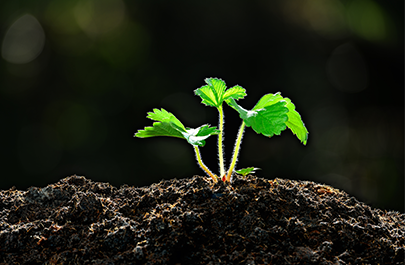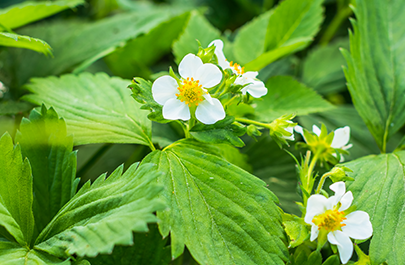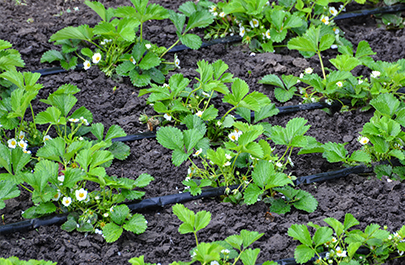






In the field, strawberries are usually planted as a two-year crop, as the incidence of disease increases significantly thereafter.
(Unit/t of production)
(Unit/t of production)
N
6
3
Very Sensitive
P2O5
2.2
0.5
Very Sensitive
K2O
8.5
2.8
Sensitive
MgO
1.2
0.6
Sensitive
TE
Boron (B), iron (Fe) and manganese (Mn) via foliar fertilisation
Nitrogen determines vegetative growth:
Strawberries have an increased nitrogen requirement during growth and fruit formation. They prefer ammonium nitrate, which is absorbed especially during the vegetative growth period. In cases of high temperatures or low pH, nitrate is preferred by the plant. Sufficient supply is necessary for yield formation, but an excessive nitrogen supply can cause problems such as excessive runner formation, increased susceptibility to disease, or increased sensitivity to low temperature. Nitrogen should always be added by applying topsoil, whereas phosphorus, potash and magnesium can be used for basal fertilization. Row fertilization is optimal for nitrogen application, especially in large row spacing.
Phosphate is important for good root growth:
In order to stimulate root growth in the best possible way, incorporation of phosphate, either in combination with potash or as NPK fertilizer, before setting, is advantageous. In addition, the flowering behaviour is positively influenced by a sufficient supply of phosphorus.
Potassium reduces stress:
Potassium is important for fruit ripeness, fruit colour and sufficient supply to reduce the stress symptoms caused by drought and low temperatures.
Calcium improves fruit quality:
Regular calcium (Ca) applications are recommended, especially on sandy soils. Calcium is used for building cell walls and thus for better fruit strength. Likewise, calcium is necessary for optimal resistance to sodium toxicity and decreased susceptibility to botrytis. Calcium deficiency reduces the lifespan of strawberry plants. Beyond that, a sufficient lime supply supports the soil structure; strawberries are very sensitive to compaction and waterlogging.
Magnesium and trace elements for better durability:
An adequate supply of magnesium (Mg) is important as a component of chlorophyll, needed for photosynthesis. The same goes for copper (Cu). Magnesium and copper also support the shelf life of fruits.
First application

Second application

Fertigation - fertilization via irrigation as an alternative

Basal fertilization before planting:
In order to stimulate root growth and to cover basic nutrient requirements, it is advisable to administer a portion of the nitrogen, as well as the full amount of phosphate, potassium and magnesium, via a chloride-free, potash-emphasised NPK fertilizer.
Nitrogen supplement during growth:
The necessary amount of nitrogen is given as topsoil application. The fertilized nitrogen must be immediately available, especially in the case of repeat-flowering varieties. Nitrate-based fertilizers (NAC 27 N) are the best choice. Trace elements are applied in liquid form, usually combined with crop protection measures.
Since strawberries are easily dehydrated which leads to significant losses in yield and quality, strawberries are irrigated very frequently. The continuous supply of water facilitates continuous nutrient supply through fertigation adapted to the state of development of the plant. Since strawberries prefer a salinity of 0.4-0.6mS/cm, the salt content of the fertilizer solution should not be higher than 1.25mS/cm. Covering the soil with straw or a film reduces watering requirements. Iron (Fe) and manganese (Mn) are both involved in photosynthesis and protein metabolism. Boron (B) is important for pollen fertility. These trace elements can be added in fertigation.
LAT Nitrogen Austria GmbH
St.-Peter-Strasse 25
4021 Linz, Austria















